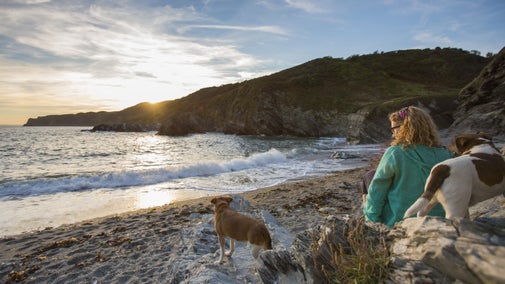
Discover Gunwalloe
Find out how to get to Gunwalloe, where to park, the things to see and do and more.

Home to one of the oldest settlements in Cornwall, Gunwalloe is steeped in history and the site of sand dunes and two rugged coves. It’s also a haven for rare wildlife and sits directly on the South West Coast Path.
There are two beaches at Gunwalloe: Church Cove and Dollar Cove. Both beaches are sandy, although there are some boulders on Dollar cove. Both have rock pools that are accessible when the tide is low, so check the tide table before arriving to make the most of your visit.
Dollar Cove takes its name from the legend of a bounty onboard the San Salvador, shipwrecked on the craggy rocks at Dollar Cove in 1669. At low tide there's plenty of space to explore along the beach and rockpools.
There are no lifeguards on duty at this beach and dogs are welcome all year round.
Church Cove is called so because of the medieval church that sits between the two coves. Weddings are common through the year and the congregation welcomes visitors at Sunday services.
There's a stream winding its way along the beach with plenty of sandy space at low & high tide. Dogs are welcome to visit the beach during the winter months, however there’s a council-enforced dog ban between 1 July–31 August 10am - 6pm.
Lifeguards are on duty here through the school summer holidays.
Access to the beaches and coast path is very simple from the National Trust car park at Gunwalloe. Dollar Cove is approximately 100 yards from the car park along a flat road, and Church Cove is a further 200 yards along. Please note that there’s no parking beyond the car park.

The reed bed at Gunwalloe is of national importance and provides a habitat and rest stop for both local birds and visiting migrant species.
Birds sighted here include wheatears, reed buntings and the rarer and often very colourful bee-eaters.
The archaeology at Gunwalloe dates back to the Bronze Age, around 1100AD. By the time of the Domesday Book in 1086, this settlement had become the royal manor of Winnianton based around Castle Mound and is thought to be one of the first settlements in Cornwall.
Gunwalloe is situated on the South West Coast Path and is almost exactly 10 miles to Lizard Point and about four miles to Porthleven.
There are numerous walks available, including one highlighted on the the visitor information board in the car park, with more walks available on the Gunwalloe web page under the 'Things to see and do' tab, including a little legs walk for young children.

Find out how to get to Gunwalloe, where to park, the things to see and do and more.
Discover the 890 miles of beautiful coastline in our care. Plan your next coastal adventure, whether you want to explore soft, sandy beaches or rugged, windswept cliffs.

There are miles of natural beautiful coastline and beaches in Cornwall to explore with all the family. There's plenty of space to blow away the cobwebs along the coast.

Try out the ‘50 things to do before you’re 11¾’ activities children can enjoy by the sea, from paddling or swimming, to catching crabs and skimming stones.

While canoeing and kayaking are great ways to experience nature and keep fit, they can be dangerous if you don't follow the guidelines. Learn how to stay safe with our advice and guidance.
